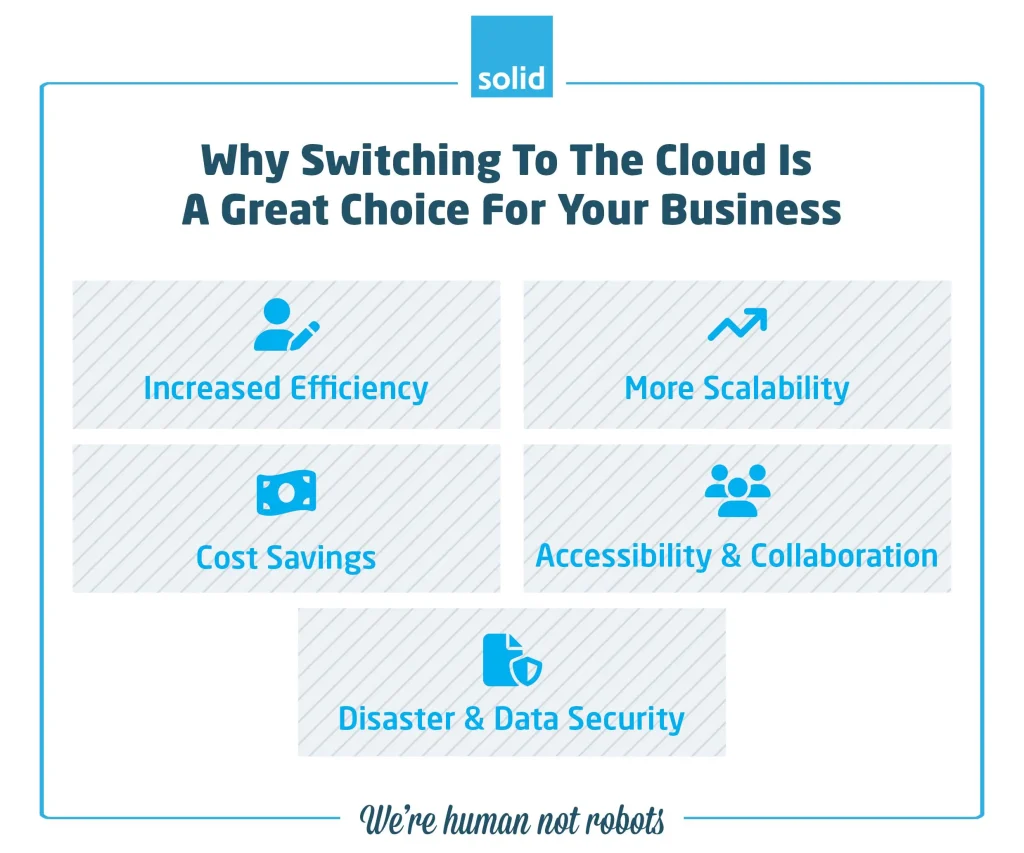
You’ve ummed and ahhed for long enough and have finally decided that it’s time to make the switch to cloud services. Congratulations! From increased efficiency and scalability to cost savings and improved collaboration, we can just about guarantee that you’ve made the right choice.
But, as with any major change for your business, it’s important to have a plan in place to ensure that the switch-over from on-premises to cloud computing is as quick, easy, affordable and painless as possible. And that’s where your cloud migration checklist comes in.
Why Switching To The Cloud Is A Great Choice For Your Business

Before we dive into the specifics of creating your cloud migration checklist, it’s good to take a moment to remind yourself of why switching to the cloud is the right move. This will serve as a reminder throughout the migration process of why you are moving to the cloud, and the value that your business is going to gain from it.
• Increased Efficiency
With cloud services, you’ll no longer have to deal with the hassle of maintaining your hardware and software on-premises. Instead, your cloud service provider is going to be by your side every step of the way, freeing up valuable time and resources for your team.
• More Scalability
Need more storage or computing power? No problem. With the cloud, you can easily scale up or down according to your business needs, without having to invest in expensive infrastructure.
• Cost Savings
Moving to the cloud can also save you money in the long run. Say goodbye to costly hardware and software upgrades, as well as maintenance fees. And because most cloud services operate on a pay-as-you-go model, you only pay for what you use.
• Accessibility & Collaboration
Once you’re set up in the cloud, your team can access files and data from anywhere in the world, as long as they have an internet connection. This will see them collaborating seamlessly, whether they’re in the office or working from home, and increase their overall productivity.
• Disaster & Data Security
Cloud service providers like Solid Systems put top-notch cybersecurity measures in place to protect your data. And with regular backups and a Disaster Recovery Plan, you can rest assured that your data is safe even if the worst-case scenario becomes a reality.
Why You Need A Cloud Migration Checklist
Once you’ve made the decision to switch to the cloud, we know that you want to dive straight in and start moving your data across to take advantage of the benefits that cloud computing is going to offer your business. But it’s important to have a plan in place for migrating your IT solutions into the cloud.
A moving to the cloud checklist will serve as your guide throughout the process, ensuring that no critical steps are missed and that your migration is completed smoothly and efficiently. Not only will it help you stay organised, but it will also serve as a reference point to track your progress and ensure that all tasks are completed before moving on to the next phase.
Cloud Migration Checklist
What Your Cloud Migration Checklist Should Include
To ensure a successful transition, here are some key components that should be included in your cloud migration checklist:
- Establish the migration architect role
- Choose the level of cloud integration that you’ll need
- Choose between single or multi-cloud
- Establish performance baselines
- Establish cloud KPIs
- Prioritise migration components
- Perform necessary adjustments to your apps
- Create a data migration plan
- Switch over to live
- Review app resource allocation
Let’s delve into each of these components a bit further to get a full understanding of what your cloud migration is going to involve, and how you’re going to need to prepare for it.
• Establish the Migration Architect Role
The first step is to assign someone from your team or hire an external IT company to be responsible for overseeing the entire migration process. This person or technology partner will serve as the main point of contact and coordinate with all stakeholders involved in the project.
• Choose the Level of Cloud Integration That You’ll Need
Before migrating, or even starting to work on your cloud migration checklist, it’s essential to determine how deeply you want to integrate your systems with the cloud. This will depend on factors such as security, budget, and compliance requirements. Consider what level of integration is necessary for your business and plan accordingly.
The two most popular levels of integration are Shallow (also known as Lift and Shift) and Deep Integration.
- Shallow Cloud Integration
Shallow Cloud Integration involves moving apps and data from your current environment directly to the cloud with minimal or no changes to the way it’s structured. This strategy is typically quicker and less costly since it doesn’t require any major redesigns, making it an attractive option for businesses looking to migrate quickly. But it is worth noting that while ‘Lift and Shift’ can streamline the migration process, it may not allow you to fully take advantage of all the capabilities and efficiencies cloud platforms offer.
- Deep Cloud Integration
Deep Cloud Integration involves making significant changes to your apps and systems to fully leverage the capabilities of the cloud. This level of integration often means that you’ll have to rebuilding apps and restructure your data so you can take advantage of cloud-specific features like scalability, distributed design, and microservices. While this method is more complex and may take longer, it can result in enhanced performance, greater scalability, lower operating costs, and better resilience against outages in the long run.
• Choose Between Single or Multi-Cloud
Another important decision to make is whether you want to use a single cloud provider or multiple providers. Each option has its advantages and disadvantages, so carefully consider your business needs before making a decision and incorporating it into your cloud migration checklist.
- Why You Might Want To Use A Single Cloud Partner
Using a single cloud provider means that all of your apps and data will be hosted on one platform. This can simplify management and reduce costs, as you won’t have to manage different systems or pay for multiple subscriptions. However, this approach also comes with risks, such as vendor lock-in and potential downtime if the cloud provider experiences an outage.
- Why You Might Want To Use Multiple Cloud Providers
Using a multi-cloud strategy can offer several benefits. It provides flexibility, enabling you to select services that best fit your needs from different providers. It also improves reliability, mitigating the effects of a potential outage in one cloud by having your services distributed. Lastly, it can help avoid vendor lock-in, giving you bargaining power and freedom to switch providers as needed.
But these advantages do come at a cost, both literally and figuratively. Using multiple providers can mean paying more for certain cloud services, since you’re splitting up your needs rather than having a single technology partner manage them all for you. Plus, managing multiple cloud partners can be a time consuming process, especially if you’re wanting to compare pricing and shift different services between providers.
- Why You Might Want To Adopt A Cloud Agnostic Approach
Being cloud agnostic means developing your apps so that they can be effectively used on any cloud platform, or even transitioned back on-premises, with minimal changes. This approach ensures that your business won’t be restricted to using a single cloud provider, giving you the option to flexibly change providers as your business needs evolve.
Taking a cloud agnostic approach to your cloud migration can mean taking a go-between stance, allowing you to work with a single cloud partner initially, but ensuring that you’re prepared in case you decide to switch providers later, or go the multi-provider route further down the line. It means that your business can easily take advantage of better pricing, improved features or superior customer service from a different cloud provider if your needs change, and enhances your system’s resilience, since you won’t be dependent on a single provider’s infrastructure.
While a cloud agnostic approach can give you more flexibility, it does also requires a greater initial investment of time and resources to ensure your apps are compatible with multiple, or all, platforms.
• Establish Performance Baselines
Before migrating to the cloud, it’s important to establish baseline metrics for your current system’s performance. This will provide a benchmark for measuring the success of your cloud migration and identifying any potential issues that may arise. It will also help to prepare you for the next step in your cloud migration testing checklist – establishing meaningful Key Performance Indicators (or KPIs) for your migration project.
To establish performance baselines, you can use tools such as load testing and monitoring software to track key metrics such as page load times, server response times, and error rates. By understanding how your system currently performs, you can make informed decisions about which areas need to be improved during the migration process.
• Establish Cloud KPIs
Having meaningful aims and KPIs is critical for measuring the success of any project, including a cloud migration. Before beginning to tick things off your cloud migration checklist, you should establish specific KPIs that align with your unique business goals and objectives. These could include increased cost savings, improved performance, or enhanced scalability. By setting clear KPIs, you can accurately measure the success of your cloud migration and make any necessary adjustments along the way.
- What Are The Different Cloud Migration KPI Categories?
Cloud Migration KPIs can be categorised into four main areas:
- Performance KPIs measure the operational efficiency and capacity of the cloud system you choose. Examples include uptime, latency, error rates, and other technical metrics.
- Financial KPIs involve cost-saving measures, return on investment (ROI), and overall financial performance of the cloud migration.
- Security KPIs measure how well your cloud environment is protecting your data. KPIs could encompass breach attempts, successful attacks, and incident response times.
- Business KPIs relate directly to your goals, such as market share, customer satisfaction, or product innovation, and how your cloud migration is contributing towards these objectives.
- What Are The Best Cloud Migration KPIs That Businesses Use
Some of the most commonly adopted Cloud Migration KPIs by businesses include:
- Cost Efficiency takes into account the financial implications of the migration, ensuring that your cloud migration is as affordable for your business as possible, and that you’re getting the maximum Return On Investment (ROI) for the time being spent migrating your apps and data.
- Performance Improvement monitors changes in app performance before and after cloud migration. It could involve measuring load times, response times, or page speeds.
- Security Compliance measures the efficiency of your cloud security measures. It could involve recording the number of security incidents, time to detect threats, and time to respond to incidents.
- Availability and Uptime assesses the reliability and availability of your cloud apps. Downtime, uptime, and service availability are key metrics to consider.
- Scalability tracks the ability of your infrastructure to handle increased demands. Metrics could include the time taken to launch new instances or handle increased loads.
- Customer Experience considers how your cloud migration impacts (and hopefully improves) your user experiences. Metrics might include app availability, performance, and customer satisfaction scores.
• Prioritise Migration Components
If only migrating to the cloud was a simple, one-step process! But it’s impossible to move everything over at once during your cloud migration. That’s why it’s important to prioritise which components of your system will be moved across first. This could include apps with high traffic or critical systems that need to maintain uptime.
By prioritising the areas of your IT to move over first, you can ensure minimal disruption to your processes, both for your humans and for your clients, and maximum business continuity.
- Planning Component Migrations
It’s important to plan out your component migration systematically. This is why your cloud migration checklist should be made up of sub-lists, like a cloud database migration checklist, a cloud migration assessment checklist, a security checklist, and even a cloud migration checklist excel document where you can keep track of the different components that need to transition to the cloud.
Start by creating a detailed inventory of all your apps, databases, and infrastructure including dependencies, usage statistics, and any special requirements.
From there, you can categorise components based on their importance to daily operations and the complexity of migration. Typically, you might want to start with less critical and less complex components to test the waters.
Once you’ve categorised your components, you’ll want to make sure that you understand how they interact, which can help prevent service interruption during migration.
Finally, create a timeline for each component’s migration, and don’t forget to include a bit of buffer time in case of unexpected roadblocks.
- Identify Service Connections
One of the most critical components to your successful cloud migration is going to be identifying all service connections within your existing IT infrastructure. These could be internal connections between different apps, or external links to third-party services. Identifying these connections upfront allows you to map out your entire system, ensuring no component or connection is left behind in the move to the cloud, and that you’re able to maintain your systems’ functionality with minimal downtime. It will also highlight connections that you may no longer need, and which can be removed altogether from your on-premises to cloud migration checklist to optimise your systems’ performance.
• Perform Necessary Adjustments To Your Apps
As you begin moving your apps and data to the cloud, you may start to notice some issues arising. This is why it’s critical to take the move into the cloud one step at a time, and to regularly consult your cloud migration security checklist.
You may need to review or refactor your data and your apps throughout the migration process to make sure that they’re running correctly and as effectively as possible. This could include updating app code for compatibility with your new cloud environment or optimising your cloud performance.
Refactoring is a crucial step for ensuring that your apps run smoothly and efficiently once they’re in the cloud. It may take additional time and resources, but it will ultimately benefit your business in the long-run by improving system performance and reducing any potential technical issues.
• Create a Data Migration Plan
Moving data to the cloud can be a complex process, so having a detailed data migration plan as part of your cloud migration checklist is essential for ensuring its success. This plan should include details on how to transfer data from your current on-premises systems to the cloud, as well as how to manage it once it’s in the cloud.
Consider factors such as data security, accessibility, and compatibility when creating your plan. It’s also crucial to test the migration of small batches of data before attempting to move large amounts. This will help identify any issues or gaps that need to be addressed before the full migration takes place.
• Switch Over To Live
Once all of your data, apps, and systems are migrated to the cloud, it’s time to switch over to using your cloud solutions. This is a crucial step to tick off your cloud migration checklist in which you will need to carefully manage and monitor your systems’ performance.
There are two common approaches that most businesses take when it comes to switching over to using their new cloud environment:
- Do It All At Once
Switching over your systems to your new environment all at the same time is often referred to as the “big bang” approach. It gives you a clean break from your legacy systems, and means that you don’t need to run your on-premises and cloud solutions at the same time, making it a more cost-effective approach to take. You’ll also get to take advantage of the full range of cloud capabilities straight away, giving your business the chance to reap the benefits of cloud services sooner.
So why don’t all businesses take this approach? Well, it requires thorough planning and testing, since switching over everything at once increases the risk of unexpected issues popping up and leading to outages and downtime where your data and apps might not be available.
- Do It A Little Bit At A Time
The alternative to switching over your systems all at once is to migrate your services to the cloud bit by bit. This ‘phased’ or ‘staged’ approach allows for more control during the migration process, since you can review your data and apps as they’re migrated over and ensure that they’re working effectively, giving you the opportunity to address any issues or challenges that arise in real time, and reducing the risk of interruptions and errors impacting your entire operation. If you’re a large business or have complex systems that need to be migrated to the cloud, this is the more cautious approach to take. While it may take longer for your cloud migration to be completed, the increased control and flexibility can be invaluable, especially when migrating critical apps and sensitive data.
• Review App Resource Allocation
During the migration process, it’s common for businesses find that their app resources also need to be adjusted. Certain apps may require more or less resources than they did in the on-premises environment, making it critical to review the way that your resources are being allocated during and after the migration process to ensure optimal performance in the cloud. This is where the KPIs the baseline performance and KPI steps that you followed earlier will come in handy, as you’ll be able to measure response times, error rates and more, and ensure that your apps are performing at least as well, if not better, in your cloud environment.
How Can Solid Systems Help?
If you’ve gotten this far, you’ve likely realised that migrating your apps, data and operations into the cloud is a complex and detailed process. And one that can be incredibly difficult to undertake on your own.
Thankfully, you don’t need to go at it alone! While this cloud migration checklist can be a handy resource in ensuring that the switch to cloud computing is as easy as possible, having a reliable and experienced cloud provider or technology partner by your side during the cloud migration process can make a huge difference.
At Solid Systems, we have over 20 years of experience, and a wealth of knowledge, to help you navigate the complexities of cloud migration with ease. We work with you to understand your unique challenges and offer tailored cloud (and cloud migration) solutions that meet your specific needs, all while reducing and mitigating the risks of transitioning to a new platform and ensuring minimal disruptions to your daily operations.
And our role doesn’t end once your data is safely stored within the cloud. We offer a vast range of cloud solutions – including cloud hosting, cloud consulting, cloud backup and cloud migration solutions – and managed IT services which see us monitoring, optimising and securing your apps and data, and helping your business to grow.
If you’re ready to start your journey towards robust and efficient cloud computing, Solid Systems is the technology partner that you need. Schedule a free consult with our Sales team today, and step into the future with confidence.
Frequently Asked Questions
While there isn’t a one-size-fits-all approach to cloud migration, there are general steps that businesses can follow to ensure a successful transition to the cloud. These include (but are not limited to):
- Choosing the level of cloud integration that your business needs
- Establishing performance baselines to compare your cloud results to
- Establishing Key Performance Indicators (KPIs) that you would like to achieve with your cloud migration
- Prioritising the migration of critical components, rather than trying to migrate everything at once
- Creating an effective data migration plan
Cloud migration tools are specialised software solutions designed to help businesses move their data and apps from on-premises infrastructure to the cloud. These tools can help simplify the complex process of migration, automate repetitive tasks, and drastically reduce the risk of data loss or downtime. Essential features to consider when choosing a migration tool include data syncing capabilities, real-time progress monitoring, error handling and rollback features. The right migration tool for your business will be based on your specific needs and goals.
Despite the numerous benefits, migrating to the cloud is not without its challenges. From concerns about the security of your data, to your apps and services not being immediately compatible with a cloud environment, to the risk of downtime during the migration process, to underestimating the cost of moving to the cloud, having a migrating to the cloud checklist can help you to prepare for the transition, and ensure that you face the challenges of moving to the cloud head-on.
The duration of cloud migration can vary greatly depending on the complexity of your apps, the volume of data, how well-prepared you are for the transition, and the specific cloud solution that you’ve chosen. For some businesses, cloud migration can take a matter of weeks, while for others, it could stretch out over months or even years. It’s crucial to remember that a well-planned and strategic migration that takes into account all facets of your operations is far more valuable than a hasty transfer. Patience and meticulous planning are instrumental in ensuring a successful transition to the cloud.





